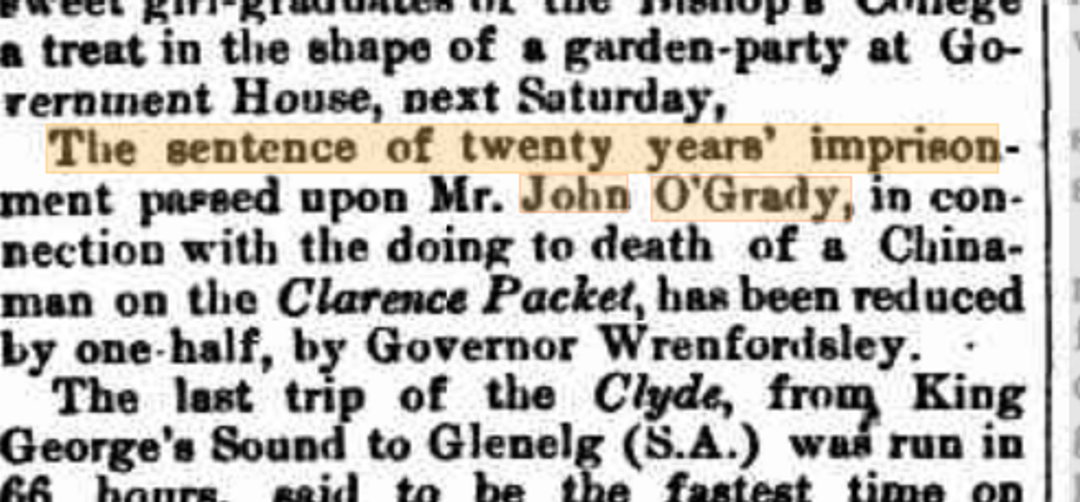Ah Soor
Vessel Name: Clarence Packet
Ah Soor
Body thrown overboard and not recovered
8 June 1881

Newspaper article 7 March 1883
John O’Grady was born in England in 1841. His family emigrated to Western Australia on 1 June 1852 on the Raleigh. His father, Henry, was a master mariner. In 1862, aged 21, John managed a salt works based on Rottnest Island. He married Jane Malone, an Irish woman, in Fremantle, when he was 22. They started a family of nine children; their first child, John Jr was born in 1865.
On 23 February 1867, Henry was the master and one of only two survivors of the Lass of Geraldton, when she was wrecked at sea. This did not deter John. He acquired his master’s certificate in 1868, and commenced work as captain of Bungaree, on a coastal run and he voyaged to East Asia for pearling crew. This led to surveying the northwest coast as master of the Ethel, while pearling in the shell fields of Exmouth and Shark Bay, John Jr started working with his father.
Ethel was one of 12 pearl vessels wrecked at the Mary Ann Patch shelling grounds when they were caught in a cyclone on 7 January 1881. She rolled and sank, and young John, aged 16 years and one native crew member drowned among the mangroves. [See the Ethel story].
John Snr survived, and four months later on 30 May 1881, he was master mariner and captain of Clarence Packet on a coastal run between Vasse and Fremantle, and pearling at Shark Bay. Jane and family were on board. It was not unusual for captains and masters to take their wives and children aboard when they set sail. In 1881 John and Jane had their eighth child, another son called John.
The Clarence Packet was built as a brig [2 masts, both with square rigging] on the Clarence River, New South Wales in 1851. She was purchased by a syndicate of 8 West Australians based in the southwest of Western Australia and registered in Fremantle as No. 4 of 1866. Her official no. was 32458.
In 1878, Clarence Packet was modified, and her tonnage increased from 48.4 to 62.9 tons [57 tonnes]. She was 72.1 long x 18.9 beam x 10.75 feet draft [22 x 5.7 x 3,2 metres]. On 14 May 1878, she was purchased by John O’Grady; William Miles, master mariner of Fremantle; Edward Stone, barrister, Perth; and Abraham Josephson, storekeeper, Perth.
On 6 June 1881 Clarence Packet left Fremantle bound for the shelling fields of Shark Bay. John O’Grady was master, and his wife was aboard, presumably with their children. Also on board were cook William Stover, mate Andrew Manham, second mate and translator Sidong, and three Malay crew members: Argo Ser, Ahmet and Hamet.
Aubrey Brown, based on Dirk Hartog Island, had arranged for 10 Chinese crew members to be delivered by the Clarence Packet. New crews were transported with stores and other cargo by the boats returning from carting shell and pearls to Fremantle. Among the Chinese men aboard Clarence Packet were Ah Soor, Ah Poo, Ah Chuk, Ah Phoon, Ah Hoo and cook Ting Chow.
The Chinese were in the habit of smoking opium after dinner and retiring to their cramped sleeping space. They had only recently come from home via Singapore and Sidong was the only crew member who could understand their language. It seems Ah Soor was seasick.
Although the first day at sea was fine, rough weather blew up on the second day, and every man on board was required to take turns at manning the single pump. The Clarence Packet was leaking badly. At midnight on 7 June 1881, Ah Phoon and Ah Chuk were called to the pump, and at 4am Ting Chow and Ah Soor were to relieve them.
Ting Chow went on deck, but Ah Soor did not, claiming seasickness. Sidong began beating Ting Chow with a rope when he cried that he could not operate the two-man pump alone. [Knotted ropes were used as a whip to punish crew]. Captain O’Grady woke and went to get Ah Soor. Ah Phoon said Ah Soor was too sick to work, but Sidong said Ah Soor must go on deck, at which point the captain came below decks.
Captain O’Grady lay about Ah Soor with the rope and held him when he attempted to escape. Although Ah Soor was a large man, he was unwell. Captain O’Grady forced him on deck, dragging him by his long plait, and continued to beat him. Then the captain kicked his abdomen hard while still holding his plait. Ah Soor fell back onto the deck, and lay there, writhing in pain for almost an hour before he became motionless.
The commotion had awoken all aboard the boat. Captain O’Grady ordered the children back to their bunks immediately. Ah Soor’s body was thrown into the sea, and nothing more was said about the incident until the boat reached its destination and was met by Aubrey Brown’s agent, James McKenna.
Captain O’Grady produced nine Chinese men, claiming one older man had fallen overboard during rough weather. He went as far as saying he had tried to catch the fellow, had called “man overboard”, and gave the order to tack and turn the boat and lowered a boat to find Ah Soor.
McKenna noted the leaks, and saturated cargo in the hold, and the constant use of the pump was confirmed by all aboard. The general condition of the boat was poor, and it was obvious she had come through bad weather. There were news reports that bulwarks were lost however McKenna disputed this detail.
The Chinese told McKenna they wanted to make a complaint about Ah Soor’s murder. McKenna doubted O’Grady’s story and sent for the police to investigate. Investigations commenced and resulted in the arrest of John O’Grady and Sidong for the murder of Ah Soor. O’Grady pleaded not guilty. He was denied bail and remanded in custody. The O’Grady family travelled south on Ariel in September 1881 for a Supreme Court criminal trial which began 11 October 1881.
Many witnesses were called, including the Chinese men and the crew of Clarence Packet. The defence team stated they relied on “christian witnesses”, including John and Jane O’Grady and Andrew Manham. O’Grady was represented by A.H.du Boulay and George Leake. The prosecutor was Inspector Timperly, and the trial was presided by Chief Justice Burt.
The details of the murder varied a great deal and presented a long and complicated trial for the jury to understand. James McKenna was a witness and provided translation for the Chinese into Malay, and Sidong translated from Malay to English. Sidong was not remanded in custody as a co-accused, but his trial was not held with O’Grady’s. The situation was most unusual.
Some details were clear; none of the witnesses thought Ah Soor could have fallen overboard, although all agreed he entered the water. Some said they saw him in the water. Manham stated he had signed a logbook which the captain had made an entry into; he stated he could identify the book but did not know what he had signed since he was illiterate.
Ah Poo was reported to be in the galley at 5.45am. Ah Chuk had been woken by Stover at 4am to make him coffee. Hamet had the helm; however, he could not see what was happening from the wheelhouse. Ting Chow and Ah Chuk were on deck. Ah Poo stated he asked them where Ah Soor was, and they saw him thrown over the side.
Apparently, O’Grady gave Sidong a pistol and ordered him to shoot if there was any further trouble. The Chinese reported there was no boat lowered. Argo Ser stated a life buoy had been moved, and Ah Chuk swore it was he who called “man overboard" when Ah Soor was thrown over and he threw the buoy not knowing that Ah Soor was already dead. Ah Chuck stated he told Hamet to turn the boat and called for the dinghy to be lowered. It remains unclear whether the dinghy was lowered or not.
John Stirling, the jury foreman questioned William Stover and Argo Ser when they provided their evidence. On the 12 October Captain John O’Grady was found guilty of the manslaughter, of Ah Soor. The jury recommended mercy, and O’Grady and was sentenced to 20 years of penal servitude.
Sidong’s trial was conducted on 15 April 1882. He was also charged with the manslaughter of Ah Soor. The Attorney General acted for the Crown and George Leake for the defence. The Attorney General stated the case had “sprung from” another case, and the two should have been heard together as a lot of the evidence was the same. The jury had a short retirement of fifteen minutes before giving their verdict of not guilty and Sidong was acquitted.
Meanwhile Hamet was working aboard the cutter Swan and Argo Ser was aboard Louisa.
On 7 March 1883 O’Grady’s sentence was reduced to 10 years following an appeal regarding the harshness of the sentence. The appeal was heard by Governor Wrensfordsley. Again, George Leake represented O’Grady.
On 5 July 1883, a petition was presented to the new Governor requesting him to exercise clemency. The foreman of the jury at O’Grady’s trial was one of 24 people who signed the petition. Twelve members of the Legislative Council the speaker of the house, and other dignitaries provided the other signatures. Jane O’Grady was receiving poor relief by December of 1883.
Three years later, on 18 October 1886, the remainder of O’Grady’s sentence was remitted, and he was released from prison. He was 45 years old. He did not return to sea, but worked on the Canning River until 1888, and then stopped work. His wife died in 1894 at the age of 52. John O’Grady died on 11 October 1923 at the age of 62 years.
As for the Clarence Packet, she was condemned as unseaworthy on 19 October 1882. After being sold to a “person not qualified to own a British vessel”, she was unregistered on 2 February 1883.
